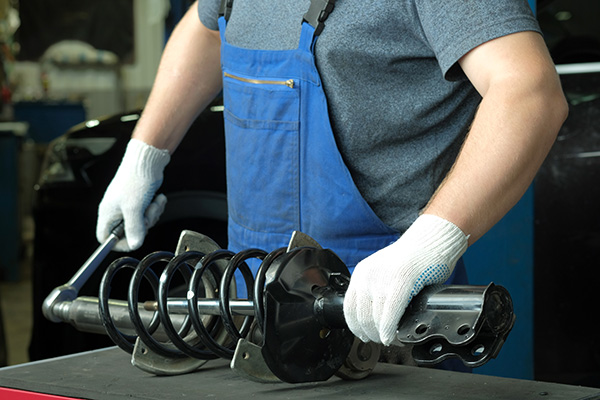
A healthy suspension keeps the tires planted, the steering precise, and the brakes consistent. When parts begin to wear, the change is gradual, so many drivers adapt without noticing.
Catching issues early prevents tire damage, protects wheel bearings and steering racks, and keeps emergency maneuvers predictable on busy Arlington roads.
Why Early Suspension Diagnosis Matters
Suspension parts share the load. When a single bushing, joint, or mount loosens up, the extra play shifts stress onto nearby components. That is why a small clunk can turn into feathered tires, shaky braking, or a steering wheel that never sits quite straight. Fixing the root cause early costs less than replacing tires and then returning a month later for the alignment that did not hold.
Symptoms You Can Feel On The Road
Listen for new noises over driveway lips, speed cushions, or rough patches. A hollow clunk points to play in a ball joint, control arm bushing, or sway bar link. A creak at parking speeds often means the rubber has dried and is twisting in its sleeve.
If the car wanders on a flat highway with light hands, or the steering wheel keeps edging off center, toe or caster may be drifting because a joint no longer controls its angle.
Excessive bounce after a speed bump suggests weak struts that cannot damp spring motion, which lengthens the stopping distance on emergency braking.
Visual Clues You Can Spot Parked
Uneven tire wear is a suspension warning you can see without tools. Inner shoulder wear hints at excessive negative camber or a bushing that allows the wheel to tip in under load. Cupping across the tread suggests the tire is bouncing because a damper is weak.
Look through the wheel spokes with a flashlight. Torn dust boots on ball joints and tie rods allow grit inside, speeding wear. A wet film on a strut or shock body means internal seals are leaking, which reduces damping and lets the tire hop on expansion joints.
Common Issues and What They Do
- Control arm bushings: Keep the wheel located front to back and in roll. When they crack, the car can pull on throttle, then pull the other way on braking.
- Ball joints: Let the wheel pivot as you steer while carrying weight. Play here changes camber under load and can produce a sharp knock on sharp turns.
- Tie rods and rack mounts: Control toe. Looseness shows up as vague steering, shimmy on patched asphalt, or a wheel that will not stay centered.
- Struts and shocks: Manage bounce. When they fade, the body floats, the nose dives, and ABS has a harder job keeping stops straight.
- Sway bar links and bushings: Resist body roll. Worn links cause the car to lean more in the sweepers.
We often find at least two small contributors at once, like a soft rear bushing plus a tired front strut, which together feel worse than either part would alone.
Preventive Maintenance That Pays Off
Rotating tires on schedule and asking for a quick suspension look at each service catches small changes early. Replace matching parts in pairs on an axle so handling stays balanced. After any suspension work, a four-wheel alignment with printouts protects new tires and keeps driver assist systems happy.
If potholes are part of your commute, consider a mid-season alignment check; small toe errors scrub tread quickly. We also suggest rechecking the torque after new arms or links settle, which helps prevent little squeaks from returning.
Get Professional Suspension Diagnosis in Arlington, TX with Euro Car Tech
If your car clunks over bumps, drifts on I-20, or shows fresh edge wear, visit Euro Car Tech in Arlington, TX. We will road test, measure, and pinpoint the actual worn component, then align the vehicle so it tracks straight and feels settled again.
Schedule a suspension inspection today and drive home with quiet, confident handling.